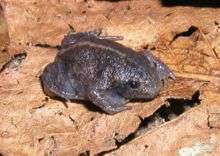Mexican burrowing toad
| Mexican burrowing toad | |
|---|---|
 | |
| Juvenile | |
| Scientific classification | |
| Kingdom: | Animalia |
| Phylum: | Chordata |
| Class: | Amphibia |
| Order: | Anura |
| Suborder: | Mesobatrachia |
| Family: | Rhinophrynidae Günther, 1859 |
| Genus: | Rhinophrynus Duméril & Bibron, 1841 |
| Species: | R. dorsalis |
| Binomial name | |
| Rhinophrynus dorsalis Duméril & Bibron, 1841 | |
| | |
| Distribution of R. dorsalis (in black) | |
The Mexican burrowing toad (Rhinophrynus dorsalis) is the only species in the genus Rhinophrynus and the family Rhinophrynidae of order Anura. These frogs live from south Texas through Mexico, Guatemala, Honduras, and El Salvador to Nicaragua and Costa Rica. The family was once more widespread, including species ranging as far north as Canada, but these died out in the Oligocene.[2]
Its name means ‘nose-toad’, from rhino- (ῥῑνο-), the combining form of the Ancient Greek rhis (ῥίς, ‘nose’) and phrunē (φρύνη, ‘toad’).[3]
Description
The Mexican burrowing toad grows to 8 cm (3.1 in) in length, and usually has red spots on its bloated body with a red stripe along the center of its back. It has short legs, and a small, pointed head. Its feet have horny, shovel-like appendages which, along with the short, powerful legs, aid it in digging. Its eyes are relatively small, and the tympanum is not visible. Unique among the frogs, the Mexican burrowing toad's tongue is projected directly out the front of the mouth, instead of being flipped out, as in all other frogs.
Ecology and behavior
As the name suggests, the Mexican burrowing toad is a burrowing animal (fossorial), and it spends a large part of its life underground. After a long period of rain, it emerges from the soil and lays eggs in a water source. It travels up to 1.6 km (1.0 mi) to find a suitable water source. Due to the unpredictability of rain, the frog can call and mate during any time of the year. It burrows into soft soil with its short legs once the environment has dried up. The egg and tadpole stages of its lifecycle are relatively short. The eggs take only a few days to hatch, and the tadpoles develop over one to three months.
The call is a loud, low-pitched "wh-o-o-o-a". When it is calling or alarmed, its body becomes inflated. The Mexican burrowing toad eats insects, primarily ants and termites.
Evolutionary independence
The Mexican burrowing toad is genetically unique in a number of ways. According to EDGE, Mexican burrowing toads are:
"The only species, within the only genus of the family Rhinophrynidae, and with over 190 million years of independent evolution, the Mexican burrowing toad is the most evolutionarily distinct amphibian species on Earth today; a fruit bat, polar bear, killer whale, kangaroo and human are all more similar to one another than this species is to any other amphibian."[4]
References
| Wikimedia Commons has media related to Rhinophrynus dorsalis. |
| Wikispecies has information related to: Rhinophrynus dorsalis |
- ↑ Georgina Santos-Barrera, Geoffrey Hammerson, Federico Bolaños, Gerardo Chaves, Larry David Wilson, Jay Savage & Gunther Köhler (2008). "Rhinophrynus dorsalis". IUCN Red List of Threatened Species. Version 2009.2. International Union for Conservation of Nature. Retrieved May 16, 2010.
- ↑ Zweifel, Richard G. (1998). Cogger, H.G. & Zweifel, R.G., ed. Encyclopedia of Reptiles and Amphibians. San Diego: Academic Press. p. 87. ISBN 0-12-178560-2.
- ↑ Dodd, C. Kenneth (2013). Frogs of the United States and Canada 1. The Johns Hopkins University Press. p. 20. ISBN 978-1-4214-0633-6.
- ↑ "EDGE: Amphibian Species Information".
- "Rhinoprynus dorsalis". Animal Diversity Web. University of Michigan. Retrieved May 8, 2006.
- "Rhinophrynidae". Animal Diversity Web. University of Michigan. Retrieved May 8, 2006.
| |||||||||||||||||||||||||||||||||||||||||||||||||||||||||||
